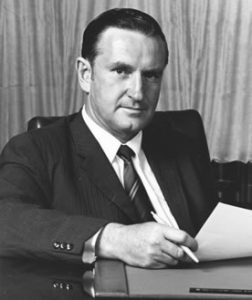Jan H Smith
Jan H Smith – ESCOM CHAIRMAN 1980 – 1985
It was said of Jan H Smith that he was always in a hurry on his way to somewhere, unlike the tortoises he raised as pets. He raised tortoises not for their speed and agility, but because he admired their tenacity.
EARLY YEARS
Jan H Smith was born in Stellenbosch in 1921, where his father was the first professor in Afrikaans at the university. Professor Smith was also the first Editor-in-Chief of the dictionary of the Afrikaans language. Jan H (as he was often called) went to Cape Town University rather than the local institution, earning a degree in electrical engineering in 1942.
INTRODUCTION TO ESCOM
He saw service in the South African Navy and was demobilised with the rank of lieutenant after the war. In 1946 he was awarded a Rhodes scholarship to Oxford, where he first obtained an Honours and later a Masters degree. He joined the head office staff of the Electricity Supply Commission in 1950 after post-graduate training in Britain.
ESCOM CAREER
Promoted to Senior System Engineer in the 1960s, he was actively involved in the early stages of planning the 400kV network that was to become part of the country-wide interconnected system in the early 1970s. He brought his classical training to the fore by introducing names from Greek mythology for the major substations: Minerva, Perseus, Hydra, Zeus, Poseidon and many others. As Assistant General Manager, he led the ESCOM negotiation team on Cahora Bassa. He was also chairman of a committee that investigated the use of computers in ESCOM and actively promoted the use of advanced technologies. His career clearly lived up to his reputation of being in a hurry. This fastidious, intense and somewhat introverted ex-naval officer was appointed Assistant General Manager in 1968 and was promoted to General Manager three years later. In 1974, Smith became an Escom Commissioner as well.
CHAIRMAN OF ESCOM
Jan H Smith was appointed chairman of ESCOM in February 1980. Like his predecessor J T Hattingh, Smith had a quick mind and a tongue to match. Few would not admit to admiring his quick wit and rapier-like dissection of knotty issues. If he had one failing, it might have been his dogged persistence in pursuing what he believed to be right, even in the light of overwhelming evidence to the contrary. He was a planner par excellence, and not many could compete with him in this most difficult area. Like so many brilliant people, he was able to reduce even the most complex problem to its bare essentials. This earned him the nickname of “Mr Kilowatt-hour” especially amongst foreign investors and bankers, who never failed to be amazed at his ability to reduce the most intractable problem to the cost effect it had on a kilowatt-hour of electricity. He could see futures that few others suspected could exist (even if he did not like them) and he knew the value of technical expertise in an organisation such as ESCOM. He wanted to get things done not at the tortoises’ pace, but certainly with their unflagging determination.
PLANNING FOR GROWTH
During the 1970s, ESCOM introduced the latest scientific methods for forecasting growth in demand. This was necessary to plan ESCOM’s expansion programme. Various sources produced economic reports for consideration. Jan H Smith and other Electricity Supply Commission members deemed a growth rate of seven to eight per cent sensible for planning purposes. This meant that Escom’s generating capacity had to double every ten years. An ambitious expansion programme was adopted. Lethabo and Tutuka power stations were under construction in the 70s. Plans were formulated to include a further trio of giant power stations: Matimba, Kendal and Majuba.
THE DE VILLIERS COMMISSION OF INQUIRY
Condemnation of the SA government’s policies increased in the 1980s. Proposed alterations to the constitution to give voting rights in a complex tri-cameral parliamentary system to Indians, coloureds and whites, but not to blacks heightened political tensions. Violence erupted and several large transformers at Arnot and Duvha power stations were sabotaged and destroyed. This contributed to the existing situation where plant shortages and breakdowns caused service interruption. The public questioned Escom’s use of the money from increased tariffs to provide for new power stations when the lights were still going out. Large consumers exerted pressure on government to do something about the utility that was gobbling up money, but giving poor service.
The government responded by announcing in May 1983 that it had appointed a Commission of Inquiry into the Supply of Electricity in the Republic of South Africa. It was headed by Dr W J de Villiers and became known as the de Villiers Commission. The Commission’s report was handed to the State President on 19 October 1983.
The Commission recommended that the existing controlling structure be replaced by a two-tier control structure, consisting of a board of control and a management board. The board of control became known as the Electricity Council consisting of 15 members. It was composed of:
• A chairman
• The Chairman or Chief Executive of the Management Board of ESCOM
• The Directors-General of the Department of Finance, and Minerals and Energy affairs
• A member nominated by the South African Transport Services
• Up to five independent experts
• One representative each from five major consumer organisations.
RETIREMENT
The Electricity Supply Commission ceased to exist in March 1985, to be replaced by an Electricity Council. Jan H Smith retired when the Commission ceased to exist. He withdrew from public life. Tragically, he was diagnosed with cancer shortly afterwards and died in Johannesburg on 23 September 1987.
ESCOM named a bursary scheme after him, and instituted the Jan H Smith Performance Award for power stations.
BIBLIOGRAPHY
The source of this material is A Symphony of Power – The Eskom Story.




